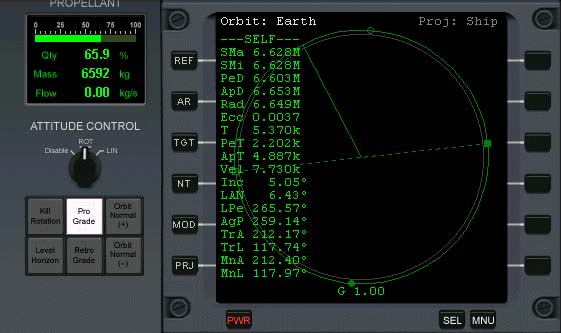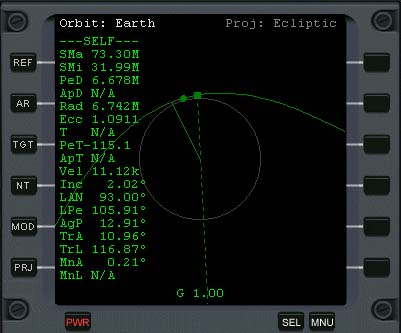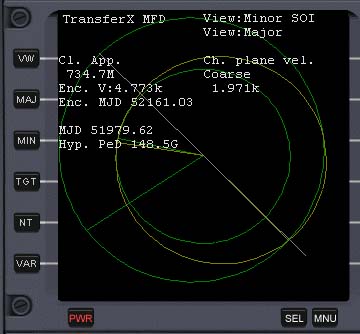'Standard Orbit, Mr Sulu'
It's a pretty good bet that you've seen the Enterprise orbiting a planet in
the Star Trek standard orbit. Of course, we can only really speculate why such
an orbit was standard in Star Trek. Perhaps it's a good orbit for scanning
planets, or avoiding being attacked by things on the surface. What we can be
sure of is that Captain Kirk's standard orbit isn't actually a very good orbit
from a navigation point of view. It's circular, but it's neither close to the planet nor far away.
It's actually not the best orbit for doing anything.
So what are the standard orbits for Orbiter? I'd say there were five
standards. Why five? The reason is that different orbits are
good for different things. Things that are easy in one orbit can be incredibly
expensive in fuel in another. So doing the right thing in the right orbit can
make the all the difference.
The Low Orbit
 When you take off from any
planet, including Earth, the first stable orbit you will (hopefully) come to is
a low circular orbit - rather like the one on the right. Unlike Captain Kirk's
standard orbit, this orbit is actually the best orbit for some things.
When you take off from any
planet, including Earth, the first stable orbit you will (hopefully) come to is
a low circular orbit - rather like the one on the right. Unlike Captain Kirk's
standard orbit, this orbit is actually the best orbit for some things.
For a start, it's the lowest energy stable orbit. Gravitational energy, by convention, is
negative. Even with all the kinetic energy tied up in the high speed movement of
your craft, your overall energy is still very negative.
Low Earth orbit is sometimes described as being 'halfway to anywhere'. The
reason is that in Low Earth orbit, your overall energy is about half as negative
as it is sitting on the surface. Add the same energy again, and you reach escape
velocity.
Understanding energy is a big part of good navigation in Orbiter. Here are
three principles to remember
Kinetic energy is proportional to velocity squared.
At 14 kilometres per second, you have FOUR TIMES as much kinetic energy as
you do at 7. If you double the energy of a low orbit, you will escape from the
planet. This therefore happens at sqrt(2) x the speed in low Earth orbit.
Increase in energy per second = thrust x velocity
The faster you are going, the more energy you can gain by opening the
throttle.
Overall energy in any orbit is a constant
Your gravitational energy and your kinetic energy equal a constant in any
orbit. The closer you get to a planet in a given orbit, the lower your
gravitational energy, and the more of your energy will show up as velocity - you
will move faster.
It is these principles that lead to the standard orbits, and their
advantages.
Advantages of a low orbit
So what are the advantages of a low circular orbit?
- It has the lowest energy of any stable orbit. This means it's the first
stopping-off point after taking off.
- It's an orbit from which you can efficiently gain further orbital energy.
There's a general principle at work here. You gain energy from thrust most
efficiently when you're moving fast, because energy increase = thrust x
velocity . And you're moving fast because you are close to the planet,
and as much as possible of your orbital energy is in the form of velocity
- You can choose to launch into almost any orbital orientation you want from
the surface. Although launching is expensive, the orientation of the orbit
comes at a very low additional energy cost
- You can transition easily to an ellipse with the semi-major axis on any
point of the orbit. The semi-major axis of an ellipse is the long axis. Just
by applying thrust prograde at any point, you instantly get an ellipse with
a semi-major axis right there.
Disadvantages of a low orbit
- It's expensive to change the orbital plane. Even small changes are
expensive. Large ones are prohibitively profligate of fuel and energy -
consider a highly elliptical orbit instead
The Highly Elliptical Orbit
This orbit has its Periapsis low - just as low as the low orbit. But the
Apoapsis is high - a long way above the planet. For Earth, I often use an orbit
with a period of a few days.
Advantages of the highly elliptical orbit
- It's still efficient if you want to gain further orbital energy. You can
do this by thrusting at Periapsis, when you are travelling fast. On Earth,
you can easily reach 10k per second at the low part of the orbit.
- The BIG advantage of this orbit is that it overcomes the fault of the low
orbit. It can be cheap to change the orbital plane. You do this by adjusting
the orbit when you are far away from the planet. It's most efficient at
Apoapsis, but it's reasonably efficient at any point on the orbit that's a
half-decent distance from the planet.
- If the planet below has an atmosphere, you can cheaply get back to a
circular orbit again by lowering Periapsis slightly into the atmosphere
below. Aerobraking will then lower apoapsis on every orbit.
- It's easy to raise and lower Periasis if you want to, by thrusting at
Apoapsis.
Disadvantages of the highly elliptical orbit
- It can be difficult to change the orientation of the semi-major axis.
Small changes aren't too bad, but large changes are best made by
transitioning to a high circular orbit. It's best to ensure that the
semi-major axis is in the right place in the first instance when creating
the orbit.
The low hyerbolic orbit

This orbit still has a low Periapsis - just as low as the low orbit. But now
there IS no Apoapsis.
Advantages of the low hyperbolic orbit
- When you're still some distance from the planet, it's cheap to change the
orbital plane in all the same sorts of ways as you can with a highly
elliptical orbit
- Because it goes low, the craft moves fast relative to the planet. And
because it goes fast, it's efficient to either add or remove orbital energy
at Periapsis.
- You get quite a lot of speed at infinity for almost no extra thrust at
Periapsis. Let's take Earth as an example. The table shows that what you get
- it's as close to getting something for nothing as you're ever likely to
see, and its a classic example of the importance of understanding how
kinetic energy works
| To have this speed at infinity |
You need this speed at Periapsis |
| 0 km/s |
10.9 km/s - Escape velocity |
| 1 km/s |
Escape velocity +45.6 metres per second |
| 2 km/s |
Escape velocity + 181.9 metres per second |
| 5 km/s |
Escape velocity + 1092 metres per second |
- This effect is most intense when Periapsis is as low as possible. It can
equally be employed in reverse. If you are approaching a planet at speed,
the most efficient way to stop is to dive close to the planet before
applying full reverse thrust at Periapsis.
- In the same way as with the highly elliptical orbit, it's not too hard to
change the plane of your orbit when at a large distance from the central
planet.
- The bigger and heavier the planet, the higher the speed at periapsis, and
the more powerful this effect becomes.
Disadvantages of the low hyperbolic orbit
- Just as with the highly elliptical orbit, it's difficult to change the
semimajor axis cheaply.
- As it's hyperbolic, you only get one chance to get it right!
The high circular orbit
This orbit is a circle a long way above the planet. In fact, the further the
better, as long as the orbit is stable. Overall, this is the least useful of the
standard orbits
Advantages of the high circular orbit
- The main advantage is total flexibility. Changing the orbital plane is
reasonably cheap, because your craft is moving pretty slowly. But its best
use is in moving between two highly elliptical orbits, when there's a need
to change the semimajor axis.
Disadvantages of the high circular orbit
- One disadvantage is that, in many cases, it still isn't that cheap to get
into a high circular orbit from a highly elliptical one. In order to make it
cheap, it needs to be VERY high.
- The main disadvantage is that it can take AGES to get anywhere. Your craft
moves slowly, and the orbit is large. Expect to use some significant time
acceleration
The Hohmann transfer orbit
 This orbit is an ellipse just touching
the two orbits of two planets. This is what you tend to
create with the transfer MFD to go from Earth to Mars. It's the most efficient
way to go between most sets of orbits. An orbit which is very close to a Hohmann
transfer is shown in yellow between the two green planetary orbits.
This orbit is an ellipse just touching
the two orbits of two planets. This is what you tend to
create with the transfer MFD to go from Earth to Mars. It's the most efficient
way to go between most sets of orbits. An orbit which is very close to a Hohmann
transfer is shown in yellow between the two green planetary orbits.
Advantage of the Hohmann transfer orbit
- The main advantage of this orbit is that minimises the acceleration
required at both ends of the orbit to match speed with the target object.
It's worthwhile getting a slight overlap with the target orbit just to make
sure that you DO get there. But large overlaps can be bad news -
particularly in the inner solar system. You can end up encountering the
target planet at very high speeds.
Disadvantage of the Hohmann transfer
- It's slow. Sometimes this doesn't matter decisively when compared to the
advantage above. But when going to Neptune, it's just too slow. A Hohmann
transfer to Saturn takes around four years.
- For the pure Hohmann transfer, it's often impossible to align the orbital
planes using the cheap speed you can gain leaving a planet with a low
hyperbolic orbit. This can be addressed by using a shorter and more
eccentric transfer. For more on this method of flying, see my
second Mars tutorial.
When you take off from any
planet, including Earth, the first stable orbit you will (hopefully) come to is
a low circular orbit - rather like the one on the right. Unlike Captain Kirk's
standard orbit, this orbit is actually the best orbit for some things.
This orbit is an ellipse just touching
the two orbits of two planets. This is what you tend to
create with the transfer MFD to go from Earth to Mars. It's the most efficient
way to go between most sets of orbits. An orbit which is very close to a Hohmann
transfer is shown in yellow between the two green planetary orbits.